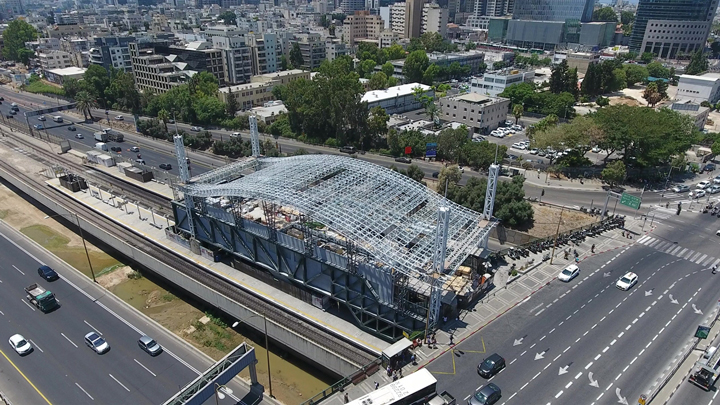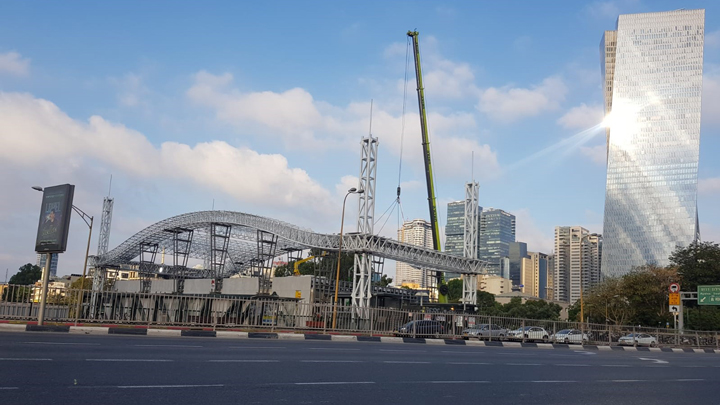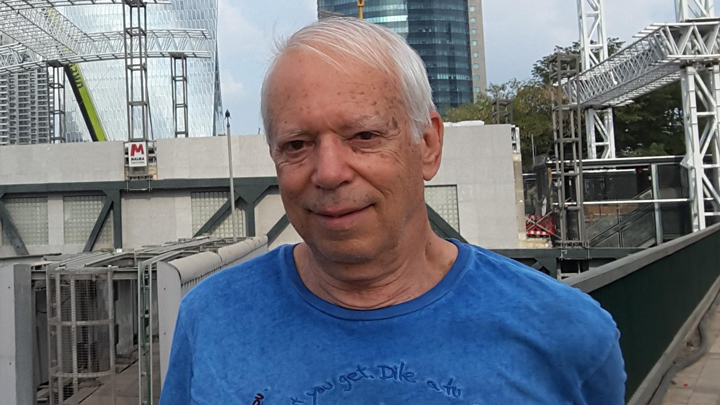His reasoning was simple. “As an architect, I design for buildings to last 100 years. By choosing CORTEN® weathering steel and painting it, you get an extremely long-lasting construction that doesn’t really need any maintenance.”
Simple, yet striking
Every day, hundreds of thousands of people in Tel Aviv pass by one of the most iconic modern buildings in Israel, the Hashalom railway station. The undulating roof, over the station’s north hall, was completed in 1996. The structural engineer for the project was Z. Zechut and the steel works (materials) were made by M.S. Malma. Now, the second south part is being erected, some 25 years later. To ensure the same look and zero maintenance enjoyed by the roof of the north hall, architect Eri Goshen chose to use COR-TEN® weathering steel coming from SSAB.
Once completed, the roofs will create a 250-meter-long steel and glass carpet that will hover over the railway and highway, taking travelers that pass by on a voyage.
“The idea of the hall is simple, yet striking,” explains architect Eri Goshen. “It is actually quite a small building in comparison to its importance and when you pass by with a car horizontally, it creates a moving wave – like a flying building. One of the things I am most proud of is that when people talk about it, they use their hands to describe its shape. It is that simple and memorable.“
Enhanced corrosion resistance
The roof is supported by eight tie-rods, which are carried by four masts. Both masts and roof are made of COR-TEN® B Tube structural hollow sections in painted condition, for increased longevity.
COR-TEN® stands for atmospheric “CORrosion” resistant high “TENsile” steel. In fact, it is a high strength low alloy steel, that becomes weather resistant thanks to the formation of a protective layer on the surface, called patina. COR-TEN® weathering steel, as part of the SSAB Weathering steel product family, finds its application as building facades, steel structures, bridges, many applications in the railway industry and poles for the electrical grid.
Painted to last
Goshen chose to use COR-TEN® B Tube structural hollow sections plus paint coating for two main reasons: low maintenance and cost savings.
“The roof consists of nearly 15,000 pieces. This means that thinking about maintenance was highly important when designing the building. Normally, one would have to paint a structure like this every 7 or 8 years to prevent corrosion and maintain the looks of the building,” explains Goshen.
By painting weathering steel, corrosion does not penetrate under the paint layer. In addition to increasing the roofs useful life, this also prevents rust colored stain drips, which would be unacceptable over a fully functioning railway station and a very busy highway.
“Using normal steel would mean that the station would have to shut down for maintenance at regular intervals,” explains Goshen. “This isn’t really an option at such a busy railways station.”
Also, because COR-TEN® weathering steel doesn’t need to be painted as often as other steels, it has less of an environmental impact compared to convention steels. The steel is also 100% recyclable. COR-TEN® weathering steel is available in a wide range of product forms, such as heavy plate, hot and cold rolled strip, tubes and sections, with min. yield strengths from 345 to 960 MPa.
Self-healing
As Goshen points out, another advantage of using weathering steel is what happens when scratches to the paint do occur.
“The structure of the roof is actually flexible and moving all of the time. This means that the welds are moving and, inevitably, the paint will crack. However, with COR-TEN® weathering steel, this will not lead to long-term corrosion damage. Any cracks that do occur will heal themselves.”
A protective patina forms on the steel surface when there is a scratch or crack through the paint layer. This protective layer seals-off the damaged area and prevents penetration of corrosion under the paint. Improved corrosion resistance dramatically decreases maintenance and repainting intervals.
Additionally, porous expanding rust is not an issue in COR-TEN® weathering steel structures, as is the case for conventional carbon steel. All this leads to the fact that the useful life of paint on weathering steel is twice that of paint on conventional steel.
“The use of COR-TEN® weathering has been a key element for ensuring the success of the railways station’s roof,” explains Goshen. “For the paint, we even chose to use an off-white color – the color of dust. As a result, in 25 years, the north hall has never been cleaned – and we expect the same for the new south-hall.”


